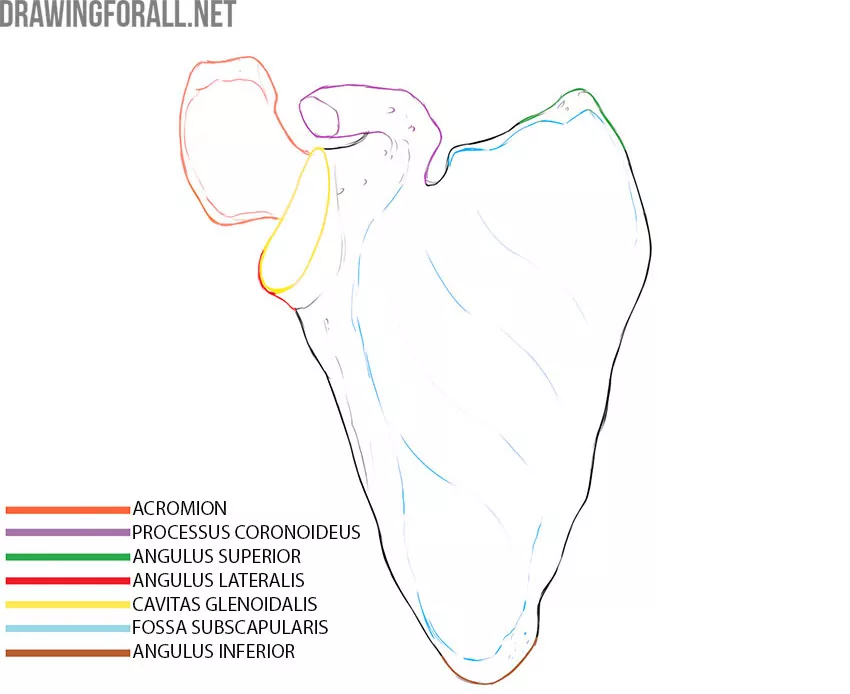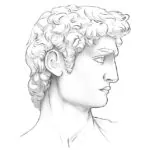Upper Limbs Skeleton Anatomy

We can do pretty cool things with our hands. Surgeons can perform masterly operations on the brain, guys at Formula 1 pit stops change wheels in 2-3 seconds, and we can create new drawing tutorials for you, dear readers.
All these things we can do because of developed arms. This is indeed a very cool evolutionary device that we will be looking at in detail today. More precisely, we will consider the skeleton of the entire upper limbs. As a rule, the upper limb, especially the hand, is a very difficult thing for artists.

The upper limb belt is formed by only two bones – the clavicle and the scapula. It’s much easier than the pelvic bones, is not it?
The upper limb girdle is attached to the rib cage with numerous muscles and ligaments, as well as the sternoclavicular joint. This is what this joint looks like:

Let’s look at each bone individually.
Scapula
The scapula is a large, flat bone that adjoins the back of the rib cage. The scapula is triangular in shape. Accordingly, we can see three corners on the shoulder blade, three edges, and several more rather important processes.

The edges of the scapula are the medial edge, the lateral edge, and the superior edge. The angles have slightly different names – upper corner, lower corner, and lateral angle.
Since, as we noted, the scapula is a flat bone, it has two surfaces. On one surface, the scapula is adjacent to the ribs, and this surface is called the rib surface. The opposite surface is directed towards the back and is therefore called the dorsal surface.
On the costal surface, we see a large fossa that takes up almost all the space. This is the subscapular fossa (fossa subscapularis), which is filled with fibers of the strong subscapularis muscle. We can also see the upper (angulus superior), lower (angulus inferior) and, lateral (angulus lateralis) angles of the scapula.

If we turn the scapula over and look at the dorsal surface, we see a large horizontal protuberance that is slightly oblique. This is the spine of the scapula (spina scapula). The space of the dorsal surface, which is located above the spine of the scapula, is called the supraspinatus fossa (fossa supraspinata), and the space under the spine is called the infraspinatus fossa (fossa infraspinata). Both pits are also filled with muscles of the same name, which are noticeably contoured in athletic people.
The tip of the scapula passes into a large rounded protrusion called the acromion. Acromion is the junction of the scapula with the clavicle. If we look at the acromion itself, we see the acromial angle and the acromial articular surface.

Near the acromion is the lateral angle of the scapula. On the lateral angle of the scapula, there is an articular back (cavitas glenoidalis). Just above the glenoid cavity is the coracoid process of the scapula (processus coracoideus); several muscles are attached to this process.
Clavicle
The clavicle is a very important bone of the upper limb that connects the rest of the upper limb to the ribcage. The clavicle is a fairly long, curved bone.

The clavicle has a clavicle body and two ends. One end is the attachment point of the clavicle to the sternum (extremitas sternalis), and the other end is the attachment point to the scapula acromion (extremitas acromialis).

The сlavicle is a bone that is fairly visible in thin people. Moreover, in a person with this type of physique, the supraclavicular fossa is also clearly visible.
The free upper limb consists of the shoulder, forearm, and hand. The skeleton of the shoulder is the humerus, and the skeleton of the forearm is the ulna and radius. The skeleton of the hand consists of many bones, which are divided into bones of the wrist, bones of the metacarpus and phalanges of the fingers.
Free Upper Limb
Humerus
The humerus is the most massive bone in the upper limb. Like any other tubular bone, the humerus has two ends – the upper and lower. The ends of the tubular bones are called epiphyses. The bulk of the mass of the humerus falls on the body of the humerus – the diaphysis.

On the upper epiphysis is the head of the humerus (caput humeri) – a rounded part that articulates with the scapula. The head, as always in anatomy, goes into a narrower part – the anatomical neck. If we move even more towards the body, we will see an even more pronounced narrowing – this is the surgical neck. This part has such an unusual name because during falls, it is the surgical neck that most often breaks.

A large tubercle and a small tubercle are located behind the head. Combs of the same name extends downward from each tubercle.
In the mid-body area, you can see the deltoid tuberosity – a clearly visible area with a rough texture, to which the powerful and strong deltoid muscle is attached.
On the lower epiphysis, there are small elevations above the articular surface, which are called epicondyles. The articular surface is called the condyle of the humerus. This surface consists of the head of the condyle of the humerus and the humerus block. In front of the articular surface is the coronary fossa, and behind – the fossa of the olecranon.
Radius
The humerus articulates with the ulna and radius. You may remember a little hint – the radius is on the side of the thumb and the ulna is on the side of the little finger.

So, the radius is a long, tubular bone that lies between the humerus and the hand on the side of the thumb. The radius has a head (caput radi) that goes into the neck (collum radi). A little below the neck is located the tuberosity of the radius.

Even lower is the body of the radius, which ends with an extended lower end of the bone. On the lateral side, we see the styloid process (processus styloideus radi) of the radius for articulation, and on the opposite side, the ulnar notch (incisura ulnaris) for articulation with the ulna. On our diagram, we marked the place on the back of which the incisura ulnaris is located.
Ulna
The ulna is the second bone that forms the forearm. The ulna has two ends and a body – like all tubular bones. The upper end of the ulna articulates with the humerus and radius. The lower end of the ulna articulates with the radius and bones of the hand.
The ulna has an excellent landmark by which you will remember this bone exactly and will not confuse it with the radius, even if you have forgotten the rule of the little finger and thumb. We’re talking about a very large olecranon at the top end.
Also at the top end, you can see the coronal process, which has smaller dimensions. Just below these processes, on the body of the bone, is the tuberosity of the ulna.

The body of the ulna looks like a triangular prism because of the interosseous edge protruding to the medial side.
At the distal end of the ulna, we see the head of the ulna (caput ulna) for articulation with the radius and the styloid process for articulation with the bones of the hand.
Hand Bones
The bones of the hand are the few bones that form the most mobile part of our body. It is with the help of the joints of the bones of the hand that we can make gentle and precise movements that are unattainable for all other living beings on our planet.

So, the bones of the hand are divided into bones of the wrist, bones of the metacarpus and phalanges of the fingers.
The bones of the wrist are eight small, dense bones that are arranged in two rows – proximal and distal. The proximal bones of the wrist include the scaphoid, triquetrum, lunate, and pisiform bones. The distal bones of the wrist include the trapezoid bone, trapezium bone, capitate bone, and hamate bone.

The metacarpals are long, tubular bones that are very different from the bones of the wrist. The bones of the metacarpus do not have special names, they are simply numbered from first to fifth in the direction from the thumb to the little finger. That is, the metacarpal bone of the thumb is the first metacarpal bone, and the metacarpal bone of the little finger is the fifth metacarpal bone.
The most distal row of bones in the hand is the finger bones. These are short, tubular bones that are also called phalanges. The thumb has two phalanges – proximal and distal. The rest of the fingers have three phalanges – proximal, middle, and distal.







